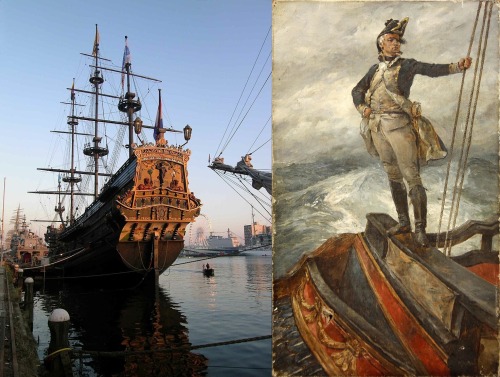Topchubashi - Sea, War And Beauty

More Posts from Topchubashi and Others






1) Dress of a Prince, high dignitary: Velvet coat, embroidered on all seams; … coat in the same way, with white lining and cuffs, embroidered with gold; … the coat is full of bees; jacket, pants and stockings are white; … Sash of gold stuff, at which the sword is attached; … black felt hat, raised by a braid and a button of gold; … white feathers; … lace tie, the Grand Cordon is carried on the coat; … the collar of the Legion of Honor is worn at the neck; … plate of the Legion of Honor is fastened on the dress and on the coat. Every great dignitary has a color assigned to him, namely: the great elector in poppy-red, the constable in big blue, the arch-chancellor of the Empire in violet; the arch treasurer in black; the arch-chancellor of State in light blue, the great admiral in green. 2) Dress of a marshal of Empire, carrying the honors: Dress and coat are in dark blue, lined with white satin, embroidered in gold on all seams, with oak and laurel leaves … black velvet cap, surmounted by a white feather; … tie of lace; … the sword is attached to a sash of golden cloth. The cushion, on which the crown of Charlemagne is resting, is in purple velvet, embroidered with golden bees. 3) Dress of a great officer of the crown: Velvet coat, lined with white silk; … the coat and the cuffs are embroidered with silver; … the velvet coat is embroidered with silver on all seams; … the pants and jacket are made of white silk, embroidered with silver; … sash of white silk, embroidered and trimmed with silver twists; … tie of lace; … black felt hat, raised by a silver braid and topped with white feathers; … the plate and the Grand Cordon are worn on the dress; … the cane is covered with velvet embroidered with bees and topped with a gold crown. Each great officer has a color assigned to his department, namely the grand chamberlain in scarlet, the grand marshal of the palace in amaranth, the Master of the Horse in light blue; the grand “veneur” (huntsman) in green, the grand master of ceremony in purple. 4) Dress of a Secretary (Ministre): The suit, coat and pants are of blue velvet, embroidered with silver; … the lining is of white silk; … the facings of the mantle are of white silk, embroidered with silver; … white moire sash, embroidered and trimmed with gold twists; … tie of lace; … the Grand Cordon is worn on the dress; … black felt hat, raised and surmounted by feathers. 5) Dress of a Colonel-General of the Hussars: White dolman and blue pelisse, embroidered with gold on all seams; … white fur; … dark blue pants, embroidered with gold; … red boots, embroidered and trimmed with gold twists; … the sabretache is red, embroidered with the arms of the Emperor and lined with golden twists; … golden sash; … shako is of black felt, embroidered with gold, with a plume and a white egret; … the plate and the Grand Cordon are worn on the dress. 6) Dress of an officer of the Imperial Household: Dress and coat of velvet, embroidered with silver and lined with white silk; … the cuffs and collar are of silvered cloth, embroidered with silver; … vest and pants of white silk, embroidered and trimmed with silver twists; … tie of lace; … black felt hat, raised by a silver braid and topped with white feathers. The same colors, worn by the great officers of the crown, distinguish officers of the Household, according to the department to which they are attached.




Janissary's sword (Janitscharenschwert) mod. 1729. Saxony. Introduced by Augustus the Strong, who had a select unit of "Janissaries" modeled after the Ottomans.

The Taffrail
A taffrail is a railing at the stern of the ship or the handrail around the open deck area at the stern of a ship or boat. The term is a shortening of taffarel, the original name for this ornament.

The stern of the Prins Willem with a wooden carved taffrail and a Captain on the Poop deck taffrail, by William Heysmann Overend (1851-1898) (x) (x)
Sometimes the railing refers only to the curved wooden top of the stern of a sailing ship or an East Indian ship. It could also be a complete handrail along the poop deck. The rail of these wooden sailing ships usually had hand-carved wooden mouldings, which were often highly ornamented.

New book of "Russian Knights" (Russkie Vityazi) publishing house. O. Leonov, V. Glazkov. Uniforms of Russian Navy. 1703-1800. This is the latest book in a series of publications about the uniform of the Russian Navy. however, chronologically it is the first one.

On October 29, 1955, near the Hospital Wall of Sevastopol Bay, after severe damage from an explosion equivalent to 1000-1200 kg of TNT, the cause of which has not yet been officially established (the official version is an explosion on a mine left over from the times of the Patriotic War), the Black Sea Fleet battleship Novorossiysk (Italian Giulio Cesare) sank. 617 people were killed — 557 people of the battleship's crew and 60 people from the personnel of the emergency parties of other ships of the squadron. Later, the ship was disassembled for metal and transferred to the Zaporizhstal plant.
-
 pissed143 liked this · 9 months ago
pissed143 liked this · 9 months ago -
 gogolex6 liked this · 1 year ago
gogolex6 liked this · 1 year ago -
 topchubashi reblogged this · 1 year ago
topchubashi reblogged this · 1 year ago





